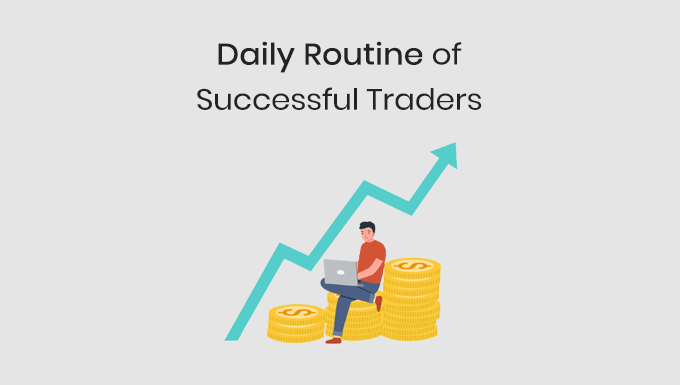Success in trading doesn’t happen overnight. It’s not a game of luck or a matter of mere chance. Rather, it’s a product of a disciplined approach, consistency, and well-calibrated strategies. One of the key elements that separate successful traders from the rest is their daily routine. While every trader has their own unique set of practices, there are common habits and methods that most successful traders adhere to. In this article, let’s talk about the daily routine of successful traders, offering insights that can help you level up your trading game.
Table of Contents
• Pre-Market Analysis and Setup
• The Execution Phase: Live Trading
• Risk Management Techniques
• Post-Market Review and Reflection
• Emotional and Psychological Preparation
• Continuing Education and Skill Development
• Conclusion
• FAQs
The Importance of a Structured Daily Routine
Why Structure is Vital
Successful traders know that consistency is key. A structured daily routine helps eliminate impulsive decisions and sets the stage for disciplined trading. This is why many of the top traders allocate specific time for different tasks, allowing them to concentrate better and make informed decisions.
Creating a Template
Just like you wouldn’t build a house without a blueprint, a trader shouldn’t begin their day without a well-thought-out trading plan. Having a clear routine acts as this blueprint, allowing traders to tackle the market with a structured mindset, which is essential for long-term success.
Establishing Discipline
By adhering to a structured routine, traders can develop and maintain the discipline needed to stick to their trading plans and strategies. Trading discipline is one of the most vital characteristics a trader can develop, and a solid routine aids in instilling this quality.
Measuring Progress
A fixed routine helps traders measure progress effectively. By conducting specific tasks at set times, they can better analyze what’s working and what’s not. This makes it easier to make incremental changes to strategies, enhancing the probability of profitability.
Flexibility Within Structure
While having a routine is essential, traders should also be adaptable. Market conditions can change rapidly, and a good trader is always prepared to adjust their routine when necessary. However, these adjustments should be thoughtful and not a result of emotional responses to the market.
Pre-Market Analysis and Setup
Importance of Preparation
The pre-market phase is a crucial period for successful traders. This is the time to conduct comprehensive market analysis, evaluate economic indicators, and review news that may impact trading for the day.
Setting Up Tools and Platforms
Before the markets open, traders set up their trading platforms and tools. This includes loading relevant charts, indicators, and keeping an eye on a list of currency pairs that you intend to trade. This setup acts as the dashboard for the trading day ahead.
Developing a Watchlist
A well-prepared watchlist can be an invaluable tool for traders. This list typically includes assets that the trader has researched and considers valuable for trading. The watchlist acts as a quick reference guide throughout the trading day.
Strategy Planning
Based on the pre-market analysis and the established watchlist, traders finalize their strategies for the day. They set profit goals, loss limits, and identify key levels for entering and exiting trades.
Simulated Trades
Some traders opt for simulated or “paper” trades based on their pre-market analysis. This helps them test their strategies without risking real capital and provides a confidence boost for the live trading session.
The Execution Phase: Live Trading
Entering the Market
The clock ticks, and the market opens. This is the moment traders have been preparing for. With pre-market analysis in hand and a watchlist at the ready, they begin executing trades based on their predefined strategies. The key is to remain disciplined and stick to the plan.
Importance of Timing
Successful traders know that timing is everything. That’s why many employ various technical indicators to ensure they’re entering or exiting the market at optimal times. Whether it’s a moving average crossover or a bullish candlestick pattern, these indicators serve as cues for action.
Monitoring and Adjusting
During the trading session, it’s crucial to monitor market conditions and individual trade performances actively. Success lies not just in the entry but in the ability to adjust positions as market conditions evolve. This could mean setting trailing stops or even reversing positions based on new information.
Keeping Records
As trades are executed, successful traders keep meticulous records. This involves jotting down entry and exit points, strategies employed, and the rationale behind each trade. These records prove invaluable for the post-market review process and future trading strategy development.
The Exit Strategy
Exiting a trade is as important as entering one. Whether hitting a pre-set stop loss or achieving the target profit level, exiting requires the same level of discipline and planning as entering. Traders must resist the temptation to let trading emotions decide when to close a position.
Risk Management Techniques
The Foundation of Trading
Effective risk management is the cornerstone of successful trading. Even the best traders experience losses, but what sets them apart is their ability to manage these losses and prevent them from turning into financial disasters.
Setting Stop Losses
One of the most common risk management techniques is setting stop-loss orders. These automated orders sell an asset when it reaches a certain price, limiting potential losses. It’s an essential part of any trader’s toolkit.
Position Sizing
Another critical aspect of risk management is position sizing, or the amount of capital allocated to a single trade. By risking only a small percentage of their portfolio on each trade, traders can survive the inevitable losses and stay in the game.
Diversification
While not always applicable to day traders who focus on short-term movements, diversification is another way to manage risk. By spreading their investments across various asset classes, traders can mitigate the impact of adverse market conditions on their portfolio.
The 1% Rule
Many successful traders adhere to the “1% Rule,” which means not risking more than 1% of the trading capital on a single trade. This allows for a cushion to absorb losses while leaving room for profitable trades to make a significant impact.
Post-Market Review and Reflection
The Importance of Review
Once the market closes, the day is far from over for successful traders. Post-market review is an essential aspect of their routine. It’s a time to analyze the day’s trades, measure performance against pre-set goals, and assess what went right or wrong.
Going Over Records
Remember those meticulous records kept during the live trading phase? This is when they come into play. Traders review these to analyze their decision-making process, evaluate their strategies, and look for ways to improve.
Metrics Matter
Successful traders pay attention to various performance metrics like win-loss ratio, average profit per trade, and drawdown. These numbers give an objective view of performance, helping traders identify areas for improvement.
Emotional Self-Assessment
Trading is an emotional rollercoaster, and emotional self-assessment is a critical part of a post-market review. Traders reflect on how emotions affected their decisions and work on strategies to improve their psychological resilience.
Strategy Adjustments
Based on the day’s performance and ongoing review, traders often make adjustments to their trading plans and strategies. This is an evolving process, aimed at enhancing both performance and risk management.
Emotional and Psychological Preparation
Mindfulness and Trading
In trading, a sound mind is as essential as a sound strategy. Successful traders often employ mindfulness techniques to enhance focus and reduce stress. This helps them approach trading with a calm and composed mindset.
Daily Affirmations
Some traders find value in daily affirmations — positive statements that help condition the mind for success. These affirmations are often read or recited before the trading day begins, setting a positive tone.
Stress Management Techniques
Trading can be stressful, but stress can cloud judgment. Effective stress management techniques like deep breathing, meditation, or even short breaks can be instrumental in maintaining emotional balance during trading.
Recognizing Emotional Triggers
Emotions can significantly affect trading performance. Recognizing emotional triggers can help traders minimize irrational decisions. This self-awareness is crucial for long-term success.
Keeping a Psychological Journal
In addition to a trading journal, some traders maintain a psychological journal. This helps them understand how their emotional states correlate with trading performance, offering insights into how emotions impact decision-making.
Continuing Education and Skill Development
Lifelong Learning
The financial markets are ever-evolving, and continuous learning is a hallmark of any successful trader. Whether it’s mastering new trading software or understanding a new market indicator, the learning never stops.
Networking and Mentorship
Networking with other traders and seeking mentorship can provide valuable insights. Learning from someone else’s experiences can sometimes be as valuable as learning from your own.
Staying Updated
Successful traders always keep an eye on forex market news, trends, and analyses. They regularly read reputable financial publications and research reports to stay updated.
Webinars and Courses
Many traders enroll in webinars, online courses, and workshops to hone their skills. These platforms provide a structured way to learn new strategies and get advice from experts.
Skill Assessment
Ongoing skill assessment is crucial for continuous improvement. By periodically reviewing their skills and strategies, traders can identify gaps in their knowledge and work to fill them.
Conclusion
The daily routine of a successful trader is a well-orchestrated blend of preparation, execution, and review. It involves rigorous pre-market analysis, disciplined trading, effective risk management, and constant self-evaluation. Balancing emotional and psychological preparation with skill development and continuing education makes the routine comprehensive. Ultimately, the secret to trading success lies in consistency, discipline, and a never-ending desire to learn and improve.
FAQs
1. Why is a structured daily routine important for traders?
A structured daily routine lays the foundation for consistent, disciplined trading. It helps traders allocate specific time for different tasks, minimizes impulsive decisions, and allows for effective performance measurement. A structured routine also aids in establishing trading discipline, which is essential for long-term success.
2. How long does it take to establish a solid trading routine?
Establishing a robust trading routine is a gradual process that varies from trader to trader. It can take anywhere from a few weeks to several months to develop a routine that aligns with your trading style, strategies, and risk tolerance.
3. Can I adapt someone else’s trading routine?
While it’s possible to start with someone else’s routine as a template, it’s essential to customize it to fit your own trading goals, strategies, and psychological makeup. What works for one trader may not necessarily work for another due to differences in risk tolerance, focus assets, and trading styles.
4. Is weekend preparation essential in a trader’s routine?
Many successful traders utilize weekends for extended analysis, strategy backtesting, and psychological preparation. Although the markets are closed, the weekend provides an invaluable ‘pause’ to reflect on past performance and plan for the week ahead.
5. How do trading styles affect daily routines?
Different trading styles, such as day trading, swing trading, and position trading, require varying routines. For instance, a day trader’s routine might involve more real-time analysis and quick decision-making, while a swing or position trader may spend more time on in-depth market analysis and long-term strategy planning.
6. Do all successful traders follow the same daily routine?
No, each trader has their own unique routine, but there are common best practices such as market analysis, risk management, and journaling.






